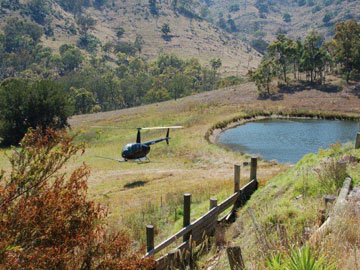
The ATSB investigation into a fatal helicopter accident has highlighted the dangers of operating overloaded helicopters.
The accident occurred on 9 December 2012, on a property near Mudgee, New South Wales. The Robinson R44 Raven I helicopter was being used to conduct aerial spraying activities. Following a number of spray runs, the helicopter failed to return to the refilling station. The helicopter was later found about 450m up a hill from the refilling station, having collided steeply with terrain. The pilot died in the accident.
The ATSB investigation found that, immediately before the accident, the helicopter was climbing up a hill at reducing speed. It was also about 33 kg above the maximum allowable weight of 1,089 kg and, crucially, too heavy for a high hover at full engine power. As the helicopter’s speed reduced below about 10 kt (20 km/h) it began to descend. The pilot did not have enough time, and possibly height, to recover and the helicopter hit a tree, before crashing steeply into the ground.
The accident tragically demonstrates the dangers of loading helicopters beyond their recommended limits, especially when undertaking operations where performance is critical, such as low flying or aerial spraying operations.
The accident tragically demonstrates the dangers of loading helicopters beyond their recommended limits, especially when undertaking operations where performance is critical, such as low flying or aerial spraying operations. Pilots should always follow manufacturers’ performance data to avoid the dangers associated with this accident.
Read the report: Loss of control involving Robinson R44 helicopter, VH-WOH, 20 km south-west of Mudgee, New South Wales, on 9 December 2012


